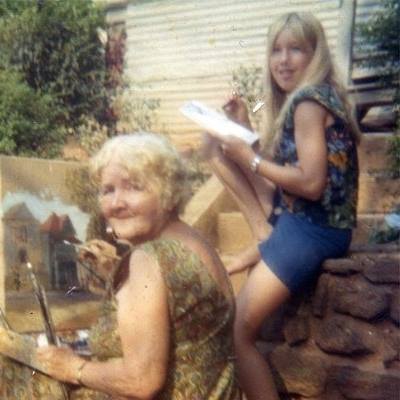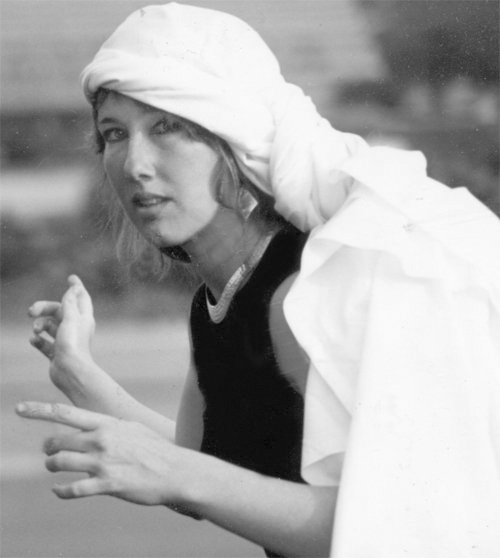Debbie was born in Lexington, Kentucky on May 14, 1958. She began drawing at age 6 inspired by her grandmother Hildegarde Hamilton, a well-known American impressionist and landscape artist (1920-1970). Debbie’s mother dabbled in portraiture but did not pursue an artist career, however her father, Harry Mack Hughes, was a professional sports photographer who worked with the University of Kentucky. Unfortunately, Debbie’s father passed away suddenly when she was 2 years old. The artist grew up in Atlanta, Georgia, later receiving a Bachelor of Fine Art from Furman University in South Carolina (1981). For at time, Debbie contemplated being a singer; she was in a rock band called HQ for five years while living in Knoxville, TN. After five years of preforming she quit when the time involved in preforming took her away from her first love of painting. After attending a science fiction convention she saw the potential for creating the type of fantastic realism she wanted to explore in her art. Her early influences were classical artists, Rembrandt van Rijn, Gericault, and surrealist Salvador Dali, later augmented by contemporary genre artists – Rodger Dean and Michael Whelan. Debbie also had a brief stint of working at the Greenville Museum of Art where she studied the works of Andrew Wyeth and N.C. Wyeth. At the time, this museum had the worlds largest collection of Andrew Wyeth’s Works. While working there Debbie was also fortunate to meet Andrew’s son Jamie Wyeth when he exhibited at the gallery as well. All three generations influenced Debbie’s work.
After moving to Knoxville, TN, Debbie became part of a group of emerging and competitive science fiction artists from Tennessee who during most of the 1980’s and 1990’s dominated science fiction art shows in the Southeastern U.S. The group came to be labled “The Tennessee Art Mafia” or “southern art mafia” and consisted of Debbie Hughes, Kevin Ward, Alan Clark, Mark Maxwell, Bob Giadrosich, Mark Poole, David O. Miller and Darryl Elliot.

Hughes worked in acrylic dry-brush and/or air-brush, usually on masonite board or panel. Her work is described often as dream-like, atmospheric, and rich in detail and color. Her science fiction works are slick, clean and high tech. In recent years, Hughes has spent a less time on photographic realism and more time on texture and exploration of thicker applications of paint. The air-brush has all but vanished as her primary tool. In recent years Debbie has converted to Oil on Panel and canvas.
Hughes’ first published work appeared on the cover of the semi-prozine Science Fiction Chronicle in 1989, when the magazine bought secondary rights to a painting she had created years earlier. In that year she also attended LunaCon, an annual Science Fiction Convention in New York, where her paintings caught the eye of Publisher Jim Baen of Baen Books. Baen commissioned Hughes to do two cover illustrations and he bought the rights to use one of her previously completed paintings for the cover of a Roger Zelazny anthology.
After Baen, Hughes began work for MBI/Easton Press books under then director Pam Pia. It was here that Hughes was allowed to shine and create works without the micro-management that she encountered from previous publishers. In addition to her continued work with Easton Press, Hughes signed on with Amazing Stories Magazine in 1991 and illustrated short stories until the magazine closed its doors in 1994. After that, Hughes signed on with Science Fiction Age magazine and illustrated for both SF Age and Realms of Fantasy, both produced by the same publisher. In addition, when the collectible game card market emerged, Hughes produced over 100 illustrations for 8 different CCG companies.

In 1992, a chance assignment for a then fledgling local computer gaming company in Knoxville, TN, Cyberflix, led Hughes to electronic media which included digital painting, animation and 3D rendering. Hughes began her work with Cyberflix producing hand-painted portraits of the main characters for their games. These images were scanned in and then animated. Later on Hughes, self-taught in computer skills, went on to animate the characters she had painted. Her first assignment was JumpRaven, an arcade game produced by Cyberflix and Paramount Interactive. This was followed by illustrations for an arcade game titled Viper, named after a television show that lasted one season. She later went on to complete illustrations for the western game, Dust, produced by the same companies. Hughes left Cyberflix in 1995 to work for another local CD rom company by the name of The Bookworm Student Library. There, Hughes returned to creating traditional art on board that was scanned in and used as illustrations for the classics of literature on CDRom. In the same town another CD rom company emerged and Hughes also worked with them both as a consultant and an illustrator. The company began as Hyperglot and produced Language learning CD’s. It was later sold to The Learning Company, that was bought by Broderbund and then the name was changed back to The Learning Company. Hughes produced both traditional hand-drawn illustrations as well as created animation work for them.
Throughout her commercial career Hughes continued doing her own personal ideas and built on them. In addition to exhibiting at Conventions Debbie continued to exhibit her works in gallery shows across the Country. In 2005, she began concentrating on her own personal idea which she describes as Magical Realism. In 2019, Debbie was inducted into the National Association of Women Artists in NY, NY. The National Association of Women Artists, Inc is an organization that was created in 1889 and includes a distinguished and limited group of women artists. Since 2019 Debbie Has had over 7 shows in NY, NY with NAWA. She has also participated in other exhibits organized by NAWA in other parts of the country.
Debbie was recently invited to show a retrospective of all her works both published and current in Lexington, Kentucky, her birthplace, at the Downtown Central Library. The Central Library invites artists only 6 times per year. Debbie work received hundreds of visitor daily from March – May 2023. In addition, her biography is published in “Science Fiction and Fantasy Artists of the Twentieth Century: A Biographical Dictionary” by Jane Frank.
Today, Debbie continues to explore her own ideas, some of which are still rooted in Science Fiction and Fantasy but others are just enigmatic themes that are non-narrative and surreal. Many of her works are also centered around our concerns over environmental threats and human travail. In her early beginnings Debbie always focused on the human condition and felt it was important to communicate that constant in a forever rapidly changing world.
Hughes has exhibited her paintings at over 100 Science Fiction shows in the U.S. and the U.K. winning many “Best in Show” awards and ribbons. She has also been the guest of Honor at fourteen conventions. In addition Hughes has exhibited at mainstream galleries in Tennessee, Georgia, Florida, Washington DC, Virginia, South Carolina, Kentucky and New York, NY. Hughes lives with her husband Dean Erickson near Lake Lanier in Buford, GA. They have two wonderful cats.